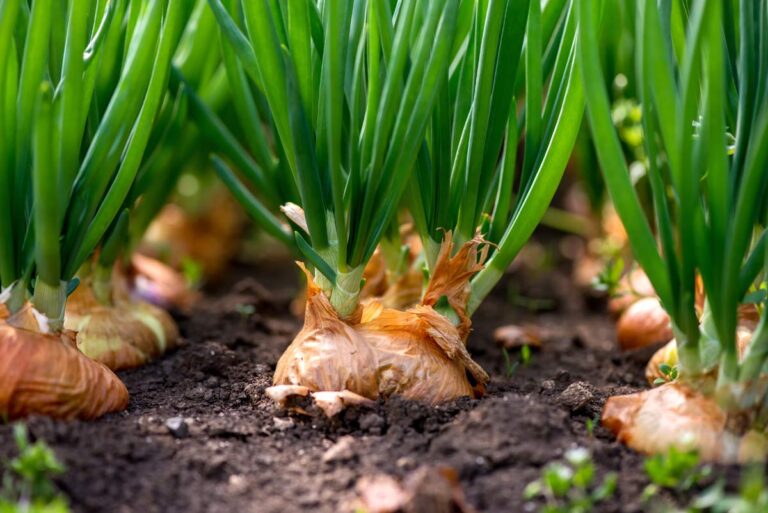Growing your spaghetti squash at home is a rewarding experience that can be enjoyed by all. Have you ever wondered what the process looks like?

From planting the seeds to harvesting the final product, there are five distinct stages of growth and development that spaghetti squash must go through in its life cycle.
In this article, we will explore each stage in detail and provide helpful tips on how to grow your healthy spaghetti squash!
Stage 1: Spaghetti Squash Germination
The first stage of spaghetti squash growth is germination.
This is the process of a seed sprouting and growing a root system, which usually takes between 2-10 days depending on temperature and humidity levels.
To ensure successful germination, it is important to keep the soil evenly moist and provide good air circulation around the seeds.
Spaghetti squash seeds should be planted at least one inch deep in well-draining soil that has been enriched with plenty of organic matter for nutrients.
After planting, cover the area with a thin layer of mulch to keep the soil warm and moist. With proper care, you can expect to see spaghetti squash seedlings emerging within 7-14 days!
Stage 2: Spaghetti squash sprouts.
Stage 2 of spaghetti squash growth is the seedling stage.
During this time, the plants will sprout their first set of true leaves which are different from the embryonic leaves that appeared during germination.
Seedlings grow and develop bigger leaves.
Keep the soil moist for optimum seedling growth.
To ensure healthy growth, use a balanced fertilizer blend and provide adequate sunlight and airflow around the plants.
Additionally, watch out for common pests like cucumber beetles, squash bugs, and squash vine borers which can all damage your plants if left untreated.
If you notice any of these pests on your plants, try using row covers or spraying them with soapy water to get rid of them quickly.
Stage 3: Spaghetti Squash Vegetation
Stage 3 of spaghetti squash growth is the vegetative stage. During this time, the plants will be growing new leaves and stem at an accelerated rate.
The plant will reach its maximum size and its height will significantly grow.
Male flowers with bushy shapes and female flowers with long thin shapes will appear and release pollen or eggs for pollination.
Fertilization leads to the formation of a fruit with seeds.
It is important to keep the soil moist but not wet during this stage as well as provide adequate sunlight and airflow to ensure healthy growth.
If you notice any signs of pests like cucumber beetles, squash bugs, or squash vine borers, use row covers or spray them with soapy water to get rid of them quickly before they can do too much damage.
Stage 4: Spaghetti Squash Propagation
Stage 4 of spaghetti squash growth is the reproductive stage.

During this stage, the plants will form male or female fruits depending on fertilization during the vegetative stage.
Male fruit is egg-shaped with a hard stem.
The female fruit appears similar, though a small squash develops from the joining of the stem and the fruit.
When ripe, they turn yellow with streaks of orange and red, resembling pumpkins or gourds.
It is important to monitor the underside of leaves for signs of common pests such as cucumber beetles and squash bugs, which can be removed using soapy water or another natural remedy.
Taking care to keep your plants healthy will ensure a plentiful harvest in late summer when you’re ready to harvest your spaghetti squash!
Stage 5: Harvesting of Squash
Stage 5: Harvesting of Squash is the final stage of the spaghetti squash life cycle. At this point, the fruits should be fully mature and ready for picking.
To determine if a fruit is ready to pick, look for its yellowish-orange color and feel it lightly. If it feels firm, then it’s time to harvest!
Make sure to take care when cutting open the fruit as its soft skin can easily be punctured and damage your crop.
For best quality, try to harvest spaghetti squash within 24 hours of ripening as they have a short shelf life after that.
Once harvested, store them in a cool, dry place away from direct sunlight or temperatures above 80 degrees Fahrenheit.
Enjoy the fruits of your labor with some delicious homemade spaghetti squash dish!
Watering Spaghetti Squash Seeds
When it comes to watering spaghetti squash seeds, it’s important to keep the soil moist but not soaked.
The best way to do this is by using a spray bottle and lightly misting the soil until it’s evenly damp.
Make sure to avoid overwatering which can lead to root rot or disease.
Additionally, avoid touching the seedling as this could damage or kill them.
For optimal results, begin watering with approximately 0.25 inches of liquid daily until the spaghetti squash seeds have sprouted.
You may need to up the amount slightly for hot weather conditions or if you live in a dry area.
Once germinated, reduce the amount of water slightly as too much can cause your seedlings to become weak and leggy from lack of support from their roots.
Finally, remember that spaghetti squashes are vining plants so they require plenty of nutrients and warmth to thrive.
Care of Spaghetti Squash Seeds
Taking care of spaghetti squash seeds is easy and rewarding. First, it’s important to choose the right type of soil for your plants.
A good soil mix should contain organic matter such as compost or manure, which will provide your plants with essential nutrients.
Additionally, adding a layer of mulch can help keep the soil temperature even and reduce water loss from evaporation.
Once you have prepped your soil, plant your spaghetti squash seeds about an inch deep and make sure to water them regularly.
Next, be on the lookout for common pests like adult squash bugs and cucumber beetles that can damage your seedlings.
If you notice any signs of infestation, use a row cover to keep them away from your plants, or treat the underside of leaves with a mixture of soapy water to kill eggs before they hatch.
In late summer and early fall, you may also need to watch out for squash vine borers which can damage or kill mature plants.
Finally, when harvesting your spaghetti squashes make sure not to leave them on the vine too long as their quality and shelf life decreases over time.
With proper care and attention, you’ll soon be enjoying delicious dishes made with freshly harvested spaghetti squash!
Growing Spaghetti Squash.
Growing Spaghetti Squash is a rewarding and relatively easy task, although there are a few steps you should take to ensure a successful harvest.

Start by choosing a planting site that receives full sun exposure, as the plants need six hours of sunlight.
It is important to have nutrient-rich soil with a pH of 6.0 to 7.5, so add plenty of compost or organic matter before planting.
Plant your Spaghetti Squash seeds when the soil has reached a temperature of 60 degrees Fahrenheit.
Monitor your seedlings for common pests such as squash bugs and cucumber beetles that can damage them; use row covers if necessary or treat the underside of leaves with a mixture of soapy water to kill eggs before they hatch.
In late summer and early fall, be on the lookout for squash vine borers which can damage or kill mature plants.
Make sure not to leave squashes on the vine too long before harvesting as their quality and shelf life decrease over time.
By following these simple steps you will soon be enjoying delicious dishes made with freshly harvested Spaghetti Squash!






